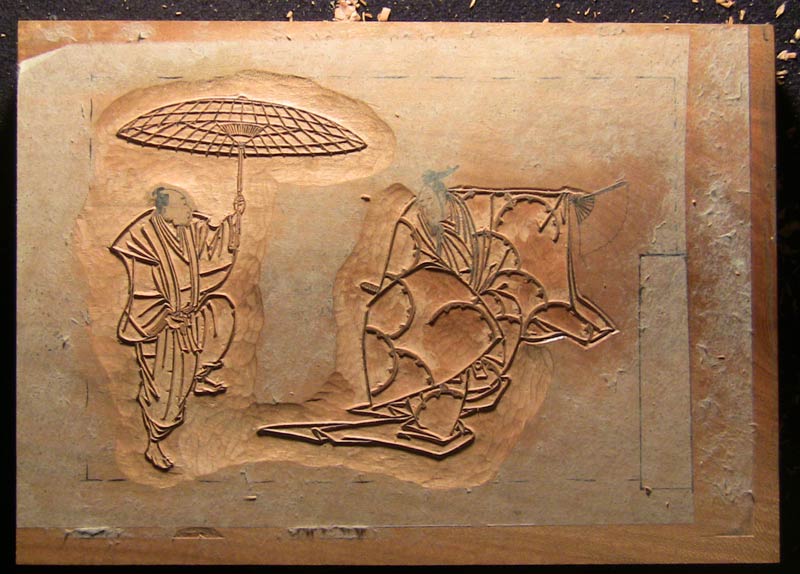Today's postings
- [Baren 45225] RE: Baren Member blogs: Update Notification (bronwyn # bronwynmerritt.com)
- [Baren 45226] Baren Member blogs: Update Notification (Blog Manager)
Digest Appendix
Postings made on [Baren] members' blogs
over the past 24 hours ...
Subject: Arts of Japan series : print #1 - keyblock carving-3
Posted by: Dave Bull
|
Plodding along at the same steady pace ...  |
This item is taken from the blog Woodblock RoundTable.
'Reply' to Baren about this item.
Subject: Paulownia supplier ...
Posted by: Dave Bull
|
As followers of the Woodblock Roundtable have seen, over the past couple of days I have been a 'good boy' and have kept my nose down at the carving bench! But I should make at least a quick post about the trip to the woodyard in Tokyo a few days ago, hunting for a good supplier for the paulownia wood we need for our projects here (both for the tool boxes, and for the cases for my own prints). Following a lead Sato-san and I sniffed out during our visit to the large lumber market at Shin-Kiba a while back, I visited a small lumber company in Kita-Senju, near the north borders of the city. Like most lumber places, this one is on the river, but lost their water access many years ago when flood control embankments were built, so their material must now be all coming by truck. When I first went in, I thought I had the wrong place, because all I could see were stacks of plywood and other 'general' woods, but after I asked the people in the office, one of them took me to a back corner of the warehouse, and up some stairs to a small storage area. Bingo.  We then sat down in the office to talk turkey. I was mostly concerned about the provenance of the stuff - locally grown, or imported from you-know-where, and it seems to be local. He wasn't actually sure how best to answer me at first, because it seems that he has had inquiries from people who are trying to avoid Japanese woods these days, for reasons you can probably guess ... I'm not really concerned about that at this stage. Spinach from one kilometre north of the Fukushima reactors I wouldn't want to eat, but - of course - such things are not on the market. Well-aged wood from the Aizu-Wakamatsu area, well inland from the problem zone? I have no trouble with that ... Over the past few weeks, Sato-san and I have learned a lot about paulownia wood, and about how it has to be treated differently from other woods during the drying/curing process. Most woods are typically resawn from the log, and then stacked (with air spaces) until they are dried. Kiln drying is of course common as well, but in both cases the main idea is to get the natural moisture out of the cells, and get the wood into a stable condition. Kiri (paulownia) is different. After resawing, it is arranged vertically in individual planks ... outdoors. In the rain. This is because the wood can't be used until the 'aku' - a kind of black substance inside the cells - has been allowed to work its way out. If the wood is simply dried in the normal fashion and then used, these black marks will become visible as time goes by, spoiling the finished product. This is not a theoretical concern for me - a number of the cases I had made for my Mystique series have become discoloured in this fashion, and it seems that some lower-grade timber made its way into the batch that was used. Luckily, it seems to have been a fairly small amount, and only some of the cases were affected. Paulownia imported from China is very white in tone, and has been treated/bleached with chemicals. I have no idea whether or not this is effective in eliminating the problem, but I do not intend to make the experiment. We're going to go with the local stuff, aged out in the rain in the traditional manner. It is - what did you expect? - more than double the price of the imported wood. And worse, rather than being in easy-to-use laid-up smooth sheets like the imported stuff:  ... it looks like this: [Long item has been trimmed at this point. The full blog entry can be viewed here] |
This item is taken from the blog Mokuhankan Conversations.
'Reply' to Baren about this item.
Subject: Northwest and Midwest contributions
Posted by: Maria
|
LD Lawrence from Sequim Washington and New York USA says: There is only one security camera in the City of The World, and it is disabled. Gayle Wohlken in Burton Ohio USA says this about her contribution: Some cats lead interesting lives above the city. With their innate sense of balance and acrobatic skills, they leap from rooftop to rooftop looking for adventure. |
This item is taken from the blog MCPP Puzzle Prints.
'Reply' to Baren about this item.
Subject: String Theory
|
[This was a summary of the original entry. The full entry can be viewed here] |
This item is taken from the blog Lori Biwer-Stewart's Printmaking Journal.
'Reply' to Baren about this item.

